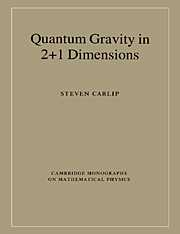Book contents
- Frontmatter
- Contents
- Preface
- 1 Why (2+1)-dimensional gravity?
- 2 Classical general relativity in 2+1 dimensions
- 3 A field guide to the (2+1)-dimensional spacetimes
- 4 Geometric structures and Chern–Simons theory
- 5 Canonical quantization in reduced phase space
- 6 The connection representation
- 7 Operator algebras and loops
- 8 The Wheeler–DeWitt equation
- 9 Lorentzian path integrals
- 10 Euclidean path integrals and quantum cosmology
- 11 Lattice methods
- 12 The (2+1)-dimensional black hole
- 13 Next steps
- Appendix A The topology of manifolds
- Appendix B Lorentzian metrics and causal structure
- Appendix C Differential geometry and fiber bundles
- References
- Index
10 - Euclidean path integrals and quantum cosmology
Published online by Cambridge University Press: 15 December 2009
- Frontmatter
- Contents
- Preface
- 1 Why (2+1)-dimensional gravity?
- 2 Classical general relativity in 2+1 dimensions
- 3 A field guide to the (2+1)-dimensional spacetimes
- 4 Geometric structures and Chern–Simons theory
- 5 Canonical quantization in reduced phase space
- 6 The connection representation
- 7 Operator algebras and loops
- 8 The Wheeler–DeWitt equation
- 9 Lorentzian path integrals
- 10 Euclidean path integrals and quantum cosmology
- 11 Lattice methods
- 12 The (2+1)-dimensional black hole
- 13 Next steps
- Appendix A The topology of manifolds
- Appendix B Lorentzian metrics and causal structure
- Appendix C Differential geometry and fiber bundles
- References
- Index
Summary
The first-order path integral formalism of the preceding chapter allows us to compute a large number of interesting topology-changing amplitudes, in which the universe tunnels from one spatial topology to another. It does not, however, help much with one of the principle issues of quantum cosmology, the problem of describing the birth of a universe from ‘nothing’.
In the Hartle–Hawking approach to cosmology, the universe as a whole is conjectured to have appeared as a quantum fluctuation, and the relevant ‘no (initial) boundary’ wave function is described by a path integral for a compact manifold M with a single spatial boundary ∑ (figure 10.1). In 2+1 dimensions, it follows from the Lorentz cobordism theorem of appendix B and the selection rules of page 157 that M admits a Lorentzian metric only if the Euler characteristic χ(∑) vanishes, that is, if ∑ is a torus. If M is a handlebody (a ‘solid torus’), it is not hard to see that any resulting spacelike metric on ∑ must be degenerate, essentially because the holonomy around one circumference must vanish. The case of a more complicated three-manifold with a torus boundary has not been studied, and might prove rather interesting. It is, however, atypical.
To obtain more general results, we can imitate the common procedure in 3+1 dimensions and look at ‘Euclidean’ path integrals, path integrals over manifolds M with positive definite metrics. Since path integrals cannot be exactly computed in 3+1 dimensions, research has largely focused on the saddle point approximation, in which path integrals are dominated by some collection of classical solutions of the Euclidean Einstein field equations.
- Type
- Chapter
- Information
- Quantum Gravity in 2+1 Dimensions , pp. 163 - 170Publisher: Cambridge University PressPrint publication year: 1998

